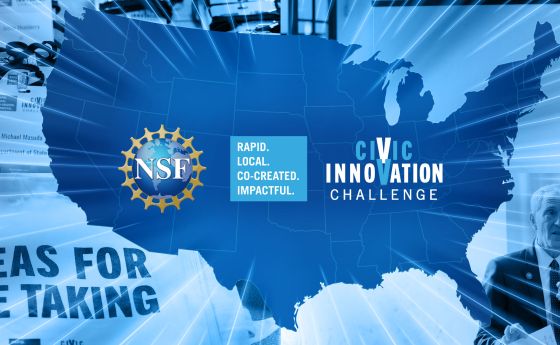
Did the pandemic set women scientists back permanently?
By Geri Richmond, National Science Board member
This past winter, in the midst of the COVID-19 pandemic, a story made the rounds on social media: A science professor was forced to stop in the middle of a very important meeting to address a loud interruption. Her child had used a paper clip to unlock the bedroom closet where she had set-up a makeshift office, revealing the woman sitting alone in the dark with her computer.
If you are a woman with young children who has tried to keep working without interruption during the pandemic you have likely experienced a similar struggle.
How did we get here? How did we end up forcing this woman – and many others like her all over the world – to resort to this extreme measure to keep her career going?
As the pandemic progressed and schools and daycares were shuttered, many female STEM faculty have felt that they had to resort to measures such as locking themselves in closets to teach their university courses or coach their graduate students on critical experiments.
Keep in mind, this is not just a problem for women, as there are many dual career couples in STEM and other careers that have struggled to manage their careers and childcare. But statistics show that women were hit the hardest by the changes wrought by COVID-19 . Those of us who have spent our careers trying to ensure that more women gain a foothold in the STEM world are discouraged and worried that this could have long-term impacts on the STEM workforce. We cannot afford to lose the gains we fought so hard to make.
In December 2020, the problem inspired the National Science Board to host a panel discussion on the Impacts of COVID-19 on Women in STEM.
Panel speakers, including experts in business management and biologists from universities such as Harvard, Purdue University and North Carolina State University, presented data that backed up the closet anecdote. They all agreed: the pandemic was revealing many long-standing problems with childcare and with expectations about career establishment and work-life balance. Panelists presented statistics which demonstrated that three groups had lost the most time from work during the pandemic: bench scientists, those caring for young children, and women. Felicia Jefferson, a researcher from Fort Valley State University, noted that some were calling COVID-19 the "first female recession" due to the huge economic impact the crisis was having on women.
"COVID-19 poses an existential threat to the female early career researcher, including graduate students, postdocs, and new professors," said Alex Hsain, a panelist and graduate student from North Carolina State University, who further noted that care work has long been extremely unbalanced in the U.S. "This has been extremely exacerbated by the COVID-19 crisis due to school shut-downs and children staying home."
As all of the speakers pointed out, most of the impact on these women was due to lack of adequate childcare. I would go even further and say it was not just that childcare disappeared. It was that we have failed to acknowledge its importance to the country in the first place.
Science is mostly an onsite in-the-lab or in-the-field career. Though some tasks can be done via remote connection, experimentalists need to be in the laboratory to do their work. This is most critical at the early career stages for graduate students, postdoctoral fellows and early career faculty members. These career stages also coincide with the biological timeclock for having children, making available and affordable childcare critical for keeping these women on the STEM career track, especially those trying to support their families on a graduate student stipend.
It is also important to note that women from the most underrepresented groups in academia -- Black, Latina and Native American women -- are likely to feel these impacts even more sharply. In her talk during the December panel, Jefferson noted the inequity of COVID's impacts, explaining that students who are Black, Indigenous or People of Color are from communities experiencing higher COVID death rates in the U.S.
Since December, data have continued to accumulate on the problem. A report published in March by the National Academy of Science, Engineering and Medicine, or NASEM, on the impact of COVID on female scientists reported that 90% of female faculty members surveyed said that the majority of their children's school and childcare demands fell on their shoulders, with only 9% reporting equally sharing such duties with their spouse. The NASEM report further indicated that this situation is widespread and could have societal impacts that last for decades.
Some solutions have been offered. In the short run, funding that could help the most vulnerable groups could be used to offset some of the impact of the pandemic's ravages upon early career STEM researchers. Thanks to Congress, NSF plans to distribute the American Rescue Plan funds to these groups, increase investments in undergraduate programs such as the Research Experience for Undergraduates sites, and support minority serving institutions and two-year colleges hardest hit by the pandemic.
Increasing institutional investments in childcare and eldercare would also be good tools for graduate student and faculty retention. Increasing salaries and stipends would also help. None of these solutions are novel or revolutionary, it should be noted. What has always been missing is the political will to make them happen on a large, meaningful scale or in a way that will permanently change the culture of academia and STEM.
With this virus mutating every day, with lives being disrupted by the effects of climate change, and with the social inequalities that compound these and other issues, the scientific community cannot afford to lose the incredible talents of half of the Earth's population.
As a woman who takes her roles as chemist and parent seriously, my heart aches for a parent who must decide between taking care of their child who is crying or participating in a Zoom call that is perceived to be critical to their career. Thinking back to the days of my physicist husband and I trying to manage our infant and toddler sons, I feel tremendous empathy for all the moms stuck in closets during the pandemic. I also know what it feels like to fear that others will think lesser of me as a scientist if they see me tending to my children, whereas my husband will more likely be seen as both a great dad and great scientist.
The time is now to learn from this pandemic and develop programs and practices to ensure that all hands can be at the lab bench. We need parents who can contribute at their full capacity and feel strong and healthy, not desperate, isolated and exhausted. Our children are the future, and they need and deserve stability to thrive.
Geri Richmond is a Professor of Chemistry at the University of Oregon and Chairs the National Science Board's External Engagement Committee.




